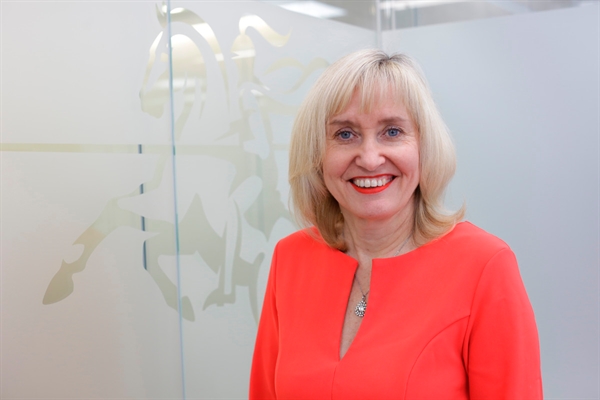Our timeline
View all Close all
1733: St George's Hospital opens
St George's Hospital opens in Lanesborough House at Hyde Park Corner. The new hospital is arranged on three floors and accommodates 30 patients in two wards, one for men and one for women.
1744: Expansion of St George's Hospital
The hospital grows to 15 wards and over 250 patients.
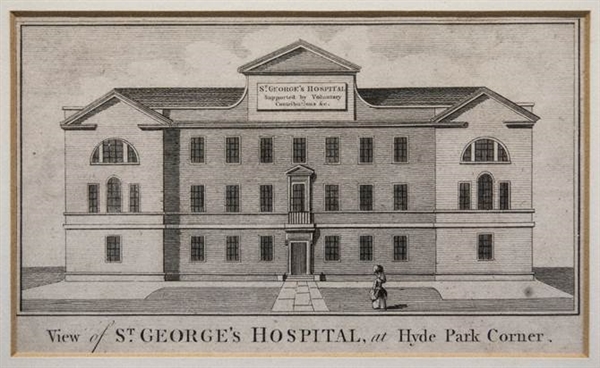
An etching of the front of St George's Hospital at Hyde Park Corner, Central London, by Toms, c.1740
1752: Formal registration of pupils
From the early days, the physicians and surgeons are permitted by the laws of the hospital to have a limited number of pupils. A formal register of pupils is maintained from 1752. The earliest recorded course of lectures at the hospital is that delivered by Sir Everard Home some time before 1803. Prior to this, there were no lectures and little regular teaching at all in the hospital other than what the students could pick up from the physicians and surgeons on their way round the wards.
1756: John Hunter
The eminent anatomist and surgeon John Hunter begins to undertake courses of study at St George's. Hunter is often referred to as the Father of Modern Surgery and is credited with transforming surgery into a sound medical practice based on a detailed understanding of human anatomy.

Line engraving of John Hunter, by W. Sharp, 1788
1796: Edward Jenner
Edward Jenner (student from 1770 to 1774) expands on the discoveries from 1774 of Benjamin Jesty, a Dorset dairy farmer who made a breakthrough when testing his hypothesis that infection with cowpox, could protect a person from smallpox. In May 1796, Jenner successfully performs his first vaccination against smallpox, leading to the eventual complete eradication of the disease in 1980. The hide of Blossom, the cow used in Jenner's smallpox experiment, was presented to St George's Medical School by Jenner's son in 1857, and has remained in the university's possession ever since.
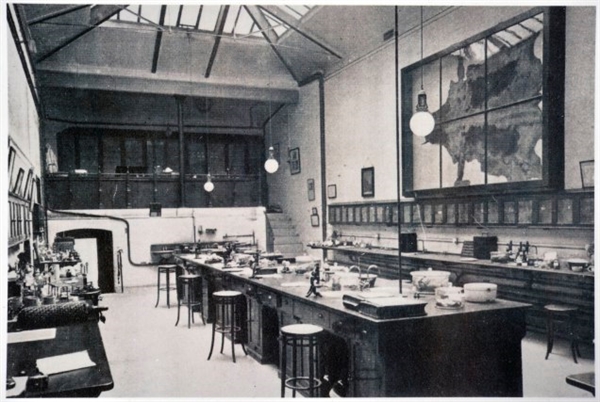
Photograph showing the hide of Blossom the cow, now located in the library at St George's Medical School
1827: Lanesborough House rebuilt
With the Lanesborough House building falling into disrepair, a competition is held to design a new 350-bed hospital building. This is won by William Wilkins, an English architect whose most famous work is the National Gallery. Building begins on new premises in 1827 and is completed in 1834. The old Lanesborough House is demolished as the new building is constructed.
1834: Medical School formally established
Surgeon Benjamin Brodie purchases a house on Kinnerton Street, which he then leases back to St George's for use as an anatomy theatre, a lecture room and a museum. Although pupils were trained at the hospital from its foundation, the medical school is not formally established until 1834 when it opens at the premises on Kinnerton Street.
1835: Official opening ceremony
The official opening ceremony for the medical school is held in 1835 in the Anatomy Theatre on the premises, and features the dissection of an ancient Egyptian mummy.
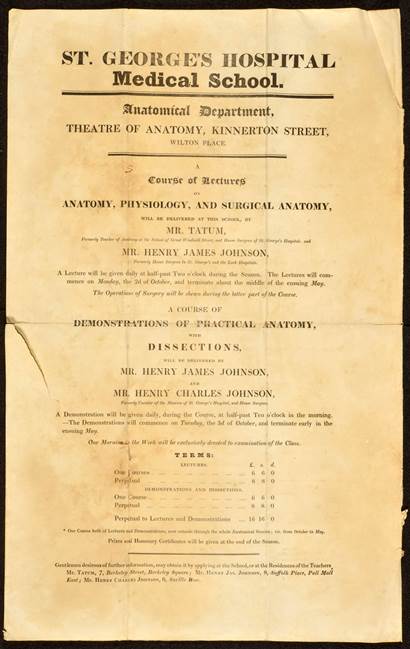
Prospectus for a course of lecturers on anatomy at the St George's Hospital Medical School at Kinnerton Street for 1837-1838, St George's Archives & Special Collections.
1836: The University of London
The medical school becomes a constituent college of the University of London soon after the latter's establishment in 1836.
1844: Benjamin Brodie
Benjamin Brodie is appointed as the first President of the Royal College of Surgeons. Brodie would also go on to be appointed the first President of the General Medical Council in 1958.
1858: Gray's Anatomy
Gray's Anatomy, the product of the collaboration between Henry Gray, perpetual student at St George's Medical School, and Henry Vandyke Carter, demonstrator in anatomy at the school, is published.
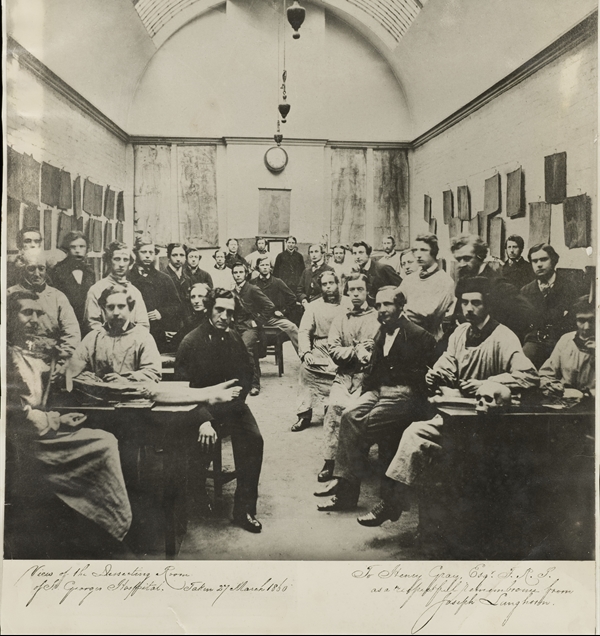
Photograph of the dissecting room at St George's Hospital, with students and lecturers, including Henry Gray, 1860.
1868: Medical school moved to main hospital site
In 1868, the Medical School at Kinnerton Street is moved to buildings at the south-west corner of the hospital site in Hyde Park itself, with the main entrance in Knightsbridge and the back entrance on Grosvenor Crescent Mews. The hospital and medical school have shared a site ever since.
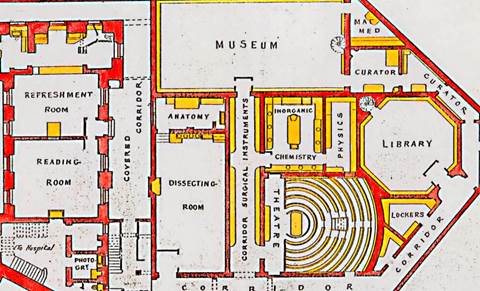
Plan for the ground floor of the new St George's Hospital Medical School at Hyde Park Corner, c.1868.
1895: Patrick Manson
Patrick Manson is appointed lecturer in Tropical Medicine and gives the first ever series of lectures on tropical diseases at St George's. Manson went on to found the London School of Hygiene and Tropical Medicine in 1899.
1899: Edward Wilson qualifies as a Doctor
Edward Wilson qualifies at St George's Hospital Medical School. On qualification he is asked to join Captain Scott's first Antarctic Expedition, leaving England in 1901 as junior surgeon and zoologist. In 1910 he joins the ill-fated expedition led by Scott to the South Pole and perishes with other members of the party on their return journey.
1915: Female students
In response to wartime staff shortages, St George's admits its first four female medical students. Helen Inglby, one of the four women accepted alongside Ethelberta Claremont, Marian M. Bostock and Elizabeth O'Flynn, goes on to become Pathologist of the Albert Einstein Medical Centre in Philadelphia in 1945.
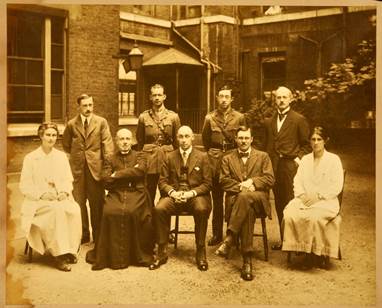
Photograph of the St George's Hospital residential house staff, with two of the Medical School's first female students, 1917.
1939-1945: Second World War
During the war years St George's becomes a unit of the Emergency Hospital Service, providing 200 beds for war casualties and 65 beds for the civilian sick. Just before the outbreak of the war, it had been decided that St George's should be rebuilt on its Hyde Park Corner site. This plan is abandoned by the commencement of the war and discussions take place which pave the way for St George's to be rebuilt and transferred out of the city centre.
1947: Dame Muriel Powell
Muriel Powell, who was trained at St George's Hospital, returns to take up the position of matron. Powell held this position for 22 years before going on to become Chief Nursing Officer for the Scottish Home and Health Department.
1948: National Health Service (NHS) introduced
The NHS comes into being on 5 July 1948 to provide healthcare for all citizens, based on need, not the ability to pay. The NHS is funded by the taxpayer and managed by the Department of Health, which sets overall policy on health issues.
With the introduction of the NHS, the hospital becomes part of the St George's Hospital Teaching Group of the South West Metropolitan Regional Hospital Board. Soon after, the Board of Governors persuades the Minister of Health, Aneurin Bevan, that the new Hospital should be built on the Grove Fever Hospital and Fountain Hospital sites in Tooting.
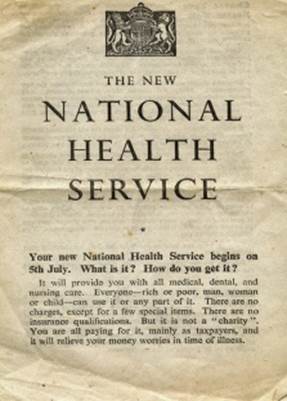
1954: Aubrey Leatham
Aubrey Leatham is appointed as St George's first consulting cardiologist. Leatham is best known for designing a new and improved version of the stethoscope, and for inventing the world's first endocardial cardiac pacemaker.
1958: First pacemaker operation
The first indwelling pacemaker operation is carried out at St George's Hospital.
1973: Building starts in Tooting
Building starts on the new St George's site at Tooting, South West London.
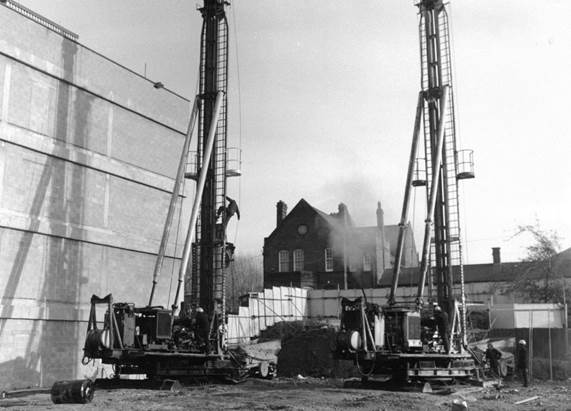
1976: Medical School opens in Tooting
The first phase of the new St George's Hospital Medical School opens in Tooting with 80 students.
1978: Patrick Steptoe
Pioneer of fertility treatment Patrick Steptoe, (alumnus, MBBS 1939), is responsible, alongside biologist and physiologist Robert Edwards, for developing in vitro fertilisation (IVF), leading to the birth of the first test-tube baby in 1978.
1980: HM The Queen opens Hospital and Medical School in Tooting
St George's at Hyde Park closes its doors for the final time and HM Queen Elizabeth II formally opens the new St George's Hospital and Medical School at Tooting on 6 November 1980. The Queen tours parts of the Hospital and the Medical School, viewing some of the school's most important historical treasures- among them, the statue, couch and chair associated with the famous surgeon, John Hunter, and the hide from Edward Jenner's cow known as Blossom.
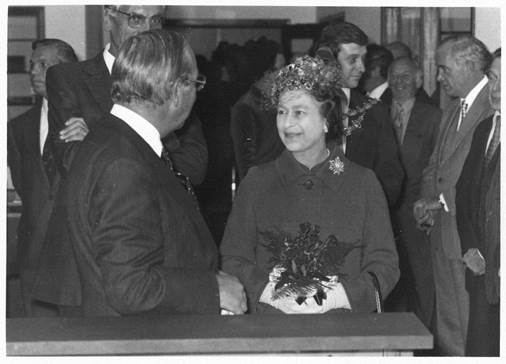
1995: Faculty of Health and Social Care Sciences Established
The Faculty of Health and Social Care Sciences, a joint collaboration between St George's, University of London and Kingston University is established, offering health and social care education in nursing, midwifery education and radiography.
2000: Graduate-entry medicine programme introduced
St George's Medical School is the first UK institution to launch the MBBS Graduate Entry Programme, a four year fast-track medical degree course open to graduates in any discipline.
2002: Widening Participation Unit
The Widening Participation Unit is launched with the purpose of promoting fair access to university for people from under represented areas of society. It has since won 15 awards, including The Guardian's Public Service Award for Innovation and Progress in Diversity and Equality and the Times Higher Education Award for Widening Participation Initiative of the Year.
2005: Medical School changes name
On St George's Day, 2005, the School formally changes its name to 'St George's, University of London'
2008: First pacemaker operation anniversary
50 years after the first pacemaker operation was carried out at St George's Hospital, the 50,000th operation is also successfully performed at the hospital.
2009: AHSN Launched
The South West London Academic, Health and Social Care Network (AHSN) is launched in October 2009, a new membership network of organisations in South West London comprising of Croydon, Kingston, Merton, Richmond, Sutton and Wandsworth – with Kingston University and St George's, University of London. The network pools members' expertise and experience to improve patient care and innovation.
2011: University of Nicosia
The first cohort of medical students enrols on the St George's Programme at the University of Nicosia, Cyprus, the first medical degree to be taught in Cyprus.
2015: First female Principal
St George's appoints its first female Principal, Professor Jenny Higham. A consultant gynaecologist who has held several leadership roles in academia, Professor Higham has research interests in reproductive medicine and medical education. She is also Chair of the Medical Schools Council.
